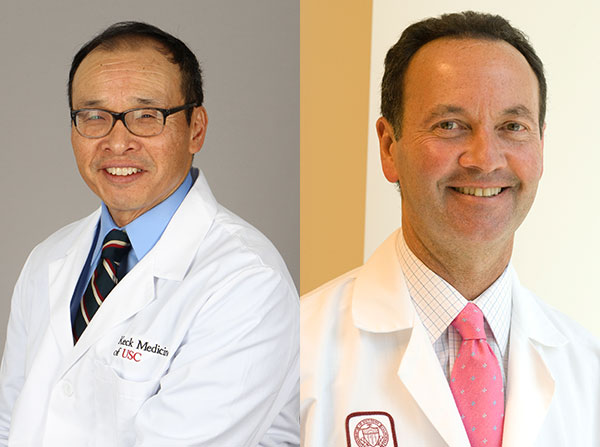
James Hu, MD and Lawrence Menendez, MD
The doctors of the sarcoma program at the USC Norris Comprehensive Cancer Center recently enrolled their final patient for a new clinical trial to test an immunotherapy treatment for sarcoma, a fact that has James Hu, MD, medical director of the sarcoma program, feeling a little more buoyant than normal.
Launching a new clinical trial is always an exciting moment, but for the doctors at the sarcoma program at USC Norris, it is particularly satisfying because the disease they treat is rare and new treatments have been elusive.
“There hasn’t been a new therapy for high grade sarcoma in over 20 years,” says Hu, noting that USC Norris is the only west coast cancer center involved in testing an immunotherapy drug for advanced sarcoma, the family of cancers that develop in connective tissue.
With fewer than 15,000 new cases a year, sarcoma is the least common form of cancer. It also has the largest number of subtypes, about 70, meaning some of the subtypes rarely show themselves.
Being small in numbers means that the word less applies often to sarcoma. There is less funding for research on sarcoma and less is known about its underlying causes. Its rarity also means that many doctors, including oncologists who treat other cancers, have little or no experience treating sarcoma.
Volume Matters
Because sarcoma is uncommon, only a handful of academic cancer centers, including the program at USC Norris, have a wealth of experience in treating sarcoma patients. The already busy practice at USC Norris is about to get busier because they recently teamed up with the sarcoma specialists at Hoag Hospital in Newport Beach, a move that will offer sarcoma patients in Orange County access to USC Norris’ services and clinical trials.
Experience is more important when it comes to sarcoma because it is more difficult to treat than other types of cancer. “Sarcomas are different animals and they defy all the fundamentals you have learned about cancer,” says Hu.
Sarcoma develops in bone, muscle, cartilage, fat or other connective tissue in any part of the body, one reason it is hard to diagnose. Making a proper diagnosis requires a multidisciplinary team, including pathologists experienced with sarcoma to accurately diagnose the many subtypes.
Only surgeons at USC Norris do biopsies when sarcoma is suspected because this is also more complicated than other types of biopsy and, when done poorly, can be costly to patients both in dollar terms and in terms of their prognosis.
Treating sarcoma typically requires some combination of surgery, chemotherapy and radiation. Lawrence Menendez, MD, chief of the center for musculoskeletal oncology, says that the combination of treatments requires perfect timing, but also a flexibility to switch treatments when necessary. “Knowing how to do this right only comes from experience,” says Menendez.
For years, the team at USC Norris has been an early adopter of pioneering treatments for sarcoma patients to effectively remove tumors, minimize recovery time and maximize functionality. The team has been at the forefront of employing 3-D computer imaging to navigate during surgery and utilizing leading edge technology such as cryoablation and radiofrequency ablation to kill tumor cells.
Novel techniques have been developed by the USC Norris team to deliver high doses of radiation to cancer cells, without the toxicity of some types of radiation, and have developed effective techniques to combine targeted radiation therapy with chemotherapy. They are currently developing new procedures to reduce radiation treatment for sarcoma patients from five to six weeks to about five days.
Robust Research
They are also constantly pushing on the research front, both in the lab and in clinical trials. There is research underway to study genomic changes in sarcoma tumors before and after therapy. Another research project
is evaluating new imaging techniques to better assess the response of patients with soft tissue sarcoma to treatment.
There are several other clinical trials underway for specific subtypes of sarcoma, some of which are showing promising early results, says Menendez. The team is also preparing to open an additional clinical trial on another new treatment for a broad range of tumors, including osteosarcoma and other sarcomas, designed to attack cancer in a novel fashion — by halting the ability of tumor cells to grow the blood vessels they need to strike and later spread cancer.
Although it will be some time before the team will be able to report preliminary results from the newest trials, such as the immunotherapy trial, Hu says he is hopeful. “It is pretty exciting and we are cautiously optimistic,” he says.
by Hope Hamashige